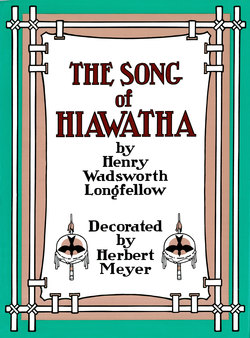Читать книгу Song of Hiawatha - Генри Уодсуорт Лонгфелло - Страница 8
ОглавлениеPUBLISHER'S FOREWORD
"Art is long and time is fleeting," Longfellow's Song of Life affirms. It's a safe assumption that Longfellow's own poetic art, in The Song of Hiawatha, will live for a long time, and that Herbert Meyer's unusual and memorable illustrations will help to perpetuate Longfellow's timeless creation.
The late Herbert Meyer's Hiawatha illustrations are unique in their relationship to the woodblock prints of the great Japanese artist Katsushika Hokusai (1760-1849). When the 23-year-old Meyer first saw Hokusai's Views of Mount Fuji, they changed his outlook, opening a "new and enchanting world" to him. He not only admitted his debt to the Japanese genre artist, but was proud of it. "What I learned from Hokusai," he wrote, "I employed in my Hiawatha pictures." Years later, the noted American artist-illustrator considered Hokusai, with Cézanne, the artist who had "played the most powerful part" in his development.
Meyer's approach to the American Indian theme was similarly enthusiastic; he did extensive research into Indian lore for the Hiawatha illustrations. His work is represented in the collections of the Metropolitan and Whitney museums in New York City, and in other museums throughout the country.
The publisher is proud to present this new edition of an old American favorite, authentically and unforgettably illustrated by a distinguished American artist.
FOREWORD
by Teiji Chizawa
Chief Curator
Tokyo National Museum
Hokusai's Views of Mount Fuji deeply influenced Herbert Meyer. "I saw life through art—very differently," he wrote, recalling his discovery of the woodblock print series by one of the leading Japanese artists of the 19th century.
Something in the Hokusai prints must have attracted this sensitive young American artist. Certainly the treatment of color, brush line, and composition in the Japanese genre (ukiyoe) print, as represented by the work of Hokusai, differs markedly from that in the European tradition of woodblock art. But the Japanese influence is shown differently in Meyer's work than in the paintings of European artists such as Vincent van Gogh and Paul Gauguin. Rather than direct quotation, we find Meyer's own appreciation and understanding of ukiyoe.
Suggestions of Hokusai can easily be detected in Meyer's techniques; the exaggeration of certain sections, heightening the effect or increasing attention by unusual, dynamic composition; the method of painting creases in mountain ranges with fragmentary, short horizontal and vertical lines; the pointillist (tembyo) touches in the depiction of falling snow. In Meyer's art, as in Hokusai's, one finds surfaces divided with heavy black outlines emphasizing shape and rhythm, or flowers and leaves printed in soft tones with a wide expanse of the same color enhancing the sense of freshness and charm. Meyer also responds to Hokusai in adapting the traditional Chinese perspective, dividing the composition into three horizontal sections to represent near, middle, and far distances; he shows interest in the vertical rectangular compositions known as hashira-e, or narrow, pillar-like designs; he does not use the Western method to indicate clouds, but experiments persistently in depicting them through stylized description.
These methods and treatments are not limited to Hokusai alone; they are the property of all Japanese woodblock artists and, moreover, of Oriental traditional art. But the classic art of that unknown country called the Orient was revealed to Meyer through Hokusai.
Meyer's attitude in absorbing the traditions of both the East and the West is honest and unpretentious. I consider particularly praiseworthy his ability to assimilate influences, making them so perfectly his own. His works would immediately strike a Japanese viewer as being very American. Hokusai can be regarded as the most Japanese of artists; I find a deep interest in Meyer's pride in being an American, vividly seen in these works based on the folklore of the native American Indian.
"My flower grew up among weeds. Up to the time I went to work at 21 (commercial art) my ideal was purely military—Edward Detaille and such. When I got well into the commercial grind this was of course quickly forgotten. I think I was 23 when I first saw (in the old Lenox Library) the 100 Views of Fuji by Hokusai. This opened up a startling new and enchanting world to me—I saw life through art—very differently. What I learned I employed in my Hiawatha pictures. . . .
France freed me—I mean my two years of living there. Then I threw everything overboard and found myself I found my real mode of expression in Vermont.
So—in review let me say that the two who played the most powerful part in planting my flower in a garden were first—Hokusai—then Cezanne. And that is really why I now paint as I do."
—From Herbert Meyer's Notebooks, 1933
